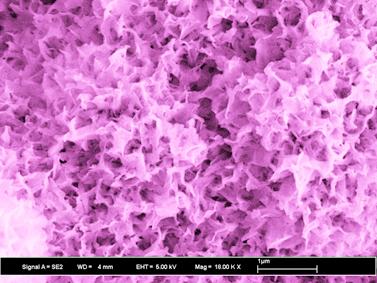Proteins choreograph the infinitesimal dance of living cells and functional biomaterials

Credit: Lehigh University | Thamma, Kowal, Falk, Jain
An interdisciplinary research team at Lehigh University has unraveled how functional biomaterials rely upon an interfacial protein layer to transmit signals to living cells concerning their adhesion, proliferation and overall development.
According to an article published today in Scientific Reports, the nanoscale features and properties of an underlying substrate do not impact the biological response of cells directly. However, these properties indirectly influence cell behavior through their control over adsorbed proteins.
In the article, “Nanostructure of bioactive glass affects bone cell attachment via protein restructuring upon adsorption,” the Lehigh team demonstrates that living cells respond to interfacial layer characteristics that arise as a consequence of micro- and nano-scale structures engineered into a substrate material. These infinitesimally-tiny structures have an enormous impact upon the nature of the proteins and how they restructure themselves and electrostatically interact with the material, which in turn influences the manner in which cells attach to the substrate and develop over time.
“There are others who have studied the interfacial protein layer,” says Himanshu Jain, the T.L. Diamond Distinguished Chair in Engineering and Applied Science and Professor of Materials Science and Engineering at Lehigh, who also serves as director of Lehigh’s Institute for Functional Materials and Devices (I-FMD). “But this work showed directly and unambiguously for the first time how some specific nanoscale features of the substrate can impact the secondary molecular structure of the proteinated interface that in turn affects the response of the cells that are thousands of times larger.”
Joining Professor Jain in guiding this research is Matthias Falk, a Professor of Cell Biology with Lehigh’s College of Arts and Sciences. The team is rounded out by two doctoral students jointly supervised by Falk and Jain–Dr. Tia Kowal, who received PhD in Biological Sciences and is now a postdoctoral researcher at Stanford Medicine, and lead author Dr. Ukrit Thamma, who completed his doctorate in Materials Science and Engineering and is now a lecturer at King Mongkut’s University of Technology in Bangkok, Thailand.
“Lehigh is increasingly recognized as a place where interdisciplinary team science is taking root and flourishing,” says Jain. “The creation and mission of Lehigh’s Interdisciplinary Research Institutes is a strategic expression of this notion–and this project is an expression of that notion in action. And the crucial role that our students play, with support from a broad faculty team, speaks for itself.”
###
To learn more about the research, please review the March 11 article “Nanostructure of bioactive glass affects bone cell attachment via protein restructuring upon adsorption” in Scientific Reports.
About Professor Jain
Dr. Jain’s research activities include functionality in glass through fundamentals. He serves as the T.L. Diamond Distinguished Chair in Engineering and Applied Science, Professor of Materials Science and Engineering, and Director of Institute for Functional Materials and Devices (I-FMD) at Lehigh University. An author of 12 patents and nearly 400 research publications, he is the editor or author of ten books or special journal issues on glass science and technology. Over the past three decades he has focused on introducing new functionality and novel processing of glass through fundamentals, and making glass education available worldwide freely. In recent years, he has been developing a student-centered model of doctoral education in STEM fields, which focuses on use-inspired research through industry-university partnership.
About Professor Falk
Matthias Falk, PhD, is Professor for Cell Biology in the Department of Biological Sciences at Lehigh University, Bethlehem, Pennsylvania, USA. Dr. Falk studied biology in Germany and received his PhD from the University of Heidelberg. In 1992 he joined the Scripps Research Institute (TSRI) in La Jolla, California, as a postdoctoral researcher, and was appointed to its faculty in 1998. He joined Lehigh University in August 2003. Dr. Falk’s research investigates the biosynthesis, structure and function of gap junctions, plasma membrane channels that provide direct cell-to-cell communication and physical cell-cell adhesion. He teaches classes and lab courses in Molecular Cell Biology on all levels. He also tests the biocompatibility and bioactivity of dual-porous glass bioscaffolds for hard tissue regeneration that were invented at NSF’s International Materials Institute for New Functionality in Glass (IMI-NFG) at Lehigh University. Dr. Falk has published over 70 manuscripts in international peer-reviewed journals, has attracted extensive extramural funding including the National Institutes of Health (NIH), and has contributed significantly to our understanding of gap junction function in physio-/pathology.
Key Links:
–Faculty profile: Himanshu Jain, Lehigh University
–Faculty profile: Matthias Falk, Lehigh University
–Researcher profile: Tia Kowal, Stanford Medicine
–Researcher profile: Ukrit Thamma, King Mongkut’s University of Technology
–Department of Materials Science and Engineering, Lehigh University
–Department of Biological Sciences, Lehigh University
–Institute for Functional Materials and Devices, Lehigh University
Media Contact
Chris Larkin
[email protected]
Original Source
https:/




